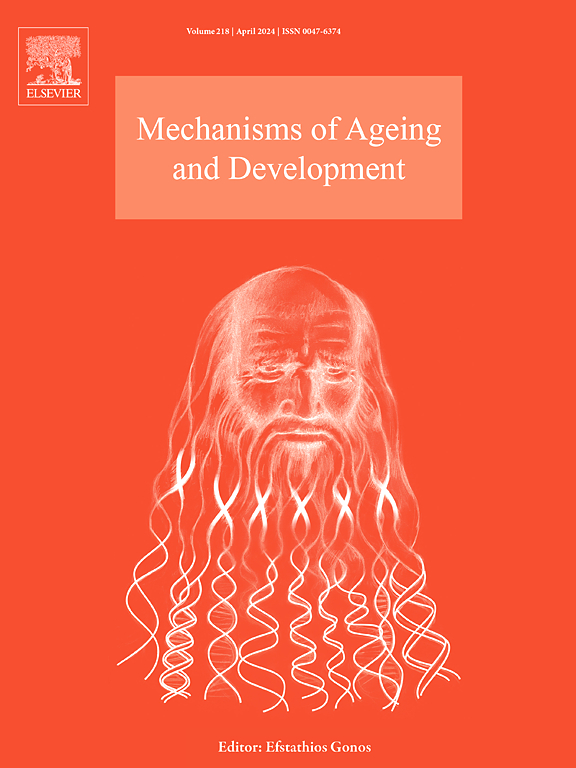Clinical data-driven classification of pre-frailty reveals sex-specific patterns – Data from the Berlin Aging Study II (BASE-II)
IF 5.1
3区 医学
Q2 CELL BIOLOGY
引用次数: 0
Abstract
Frailty is a geriatric condition with multidimensional consequences that strongly affect older adults’ quality of life. The lack of a universal standard to describe, diagnose, and treat frailty further complicates this situation. Nowadays, multitudinous frailty assessment tools are applied depending on the regional and clinical context, adding complexity by increasing heterogeneity in the definition and characterization of frailty. Better insights into the causes and pathophysiology of frailty and its early stages are required to establish strong and accurately tailored treatment rationales for frail patients. We analysed participants aged 60 and above using cross-sectional biochemical and survey data from the Berlin Aging Study II (BASE-II, N = 1512, pre-frail=470, frail=14), applying machine-learning techniques to investigate determinants of physical frailty measured by Fried et al.’s 5-item frailty phenotype. Our findings highlight new prognostic sex-specific biomarkers of pre-frailty (the early stage of frailty) with possible clinical applications, enriching the current sex-agnostic diagnostic scores with easy monitorable physical and physiological characteristics. Low appendicular lean mass and high fat composition in men, or vitamin D deficiency and high white blood cell counts in women, emerged as strong indicators of the respective pre-frailty profiles. Because the number of fully frail individuals was extremely small (n = 14, <1 %), our findings should be interpreted as reflecting predictors of pre-frailty, not of frailty itself. We conclude that understanding the development of frailty remains a complex challenge, and that sex-specific differences must be considered by clinical geriatricians and researchers.
临床数据驱动的虚弱前分类揭示了性别特异性模式——来自柏林老龄化研究II (BASE-II)的数据
虚弱是一种老年疾病,具有多方面的后果,严重影响老年人的生活质量。缺乏描述、诊断和治疗虚弱的通用标准使这种情况进一步复杂化。如今,根据地区和临床情况,应用了多种虚弱评估工具,这增加了虚弱定义和特征的异质性,从而增加了复杂性。需要更好地了解虚弱的原因和病理生理学及其早期阶段,以便为虚弱患者建立强有力和准确定制的治疗依据。我们使用来自柏林老龄化研究II (BASE-II, N = 1512,pre-虚弱=470,虚弱=14)的横断面生化和调查数据分析了60岁及以上的参与者,并应用机器学习技术来研究Fried等人的5项虚弱表型测量的身体虚弱的决定因素。我们的研究结果强调了具有潜在临床应用价值的新的预脆弱(脆弱的早期阶段)预后性别特异性生物标志物,丰富了目前的性别不可知的诊断评分,具有易于监测的生理和生理特征。男性阑尾瘦质量低、脂肪含量高,女性缺乏维生素D、白细胞数量高,这些都是各自脆弱前特征的有力指标。由于完全虚弱个体的数量非常少(n = 14,<1 %),我们的发现应该被解释为反映了虚弱前期的预测因子,而不是虚弱本身。我们的结论是,了解衰弱的发展仍然是一个复杂的挑战,临床老年病学家和研究人员必须考虑到性别特异性差异。
本文章由计算机程序翻译,如有差异,请以英文原文为准。
求助全文
约1分钟内获得全文
求助全文
来源期刊
CiteScore
11.10
自引率
1.90%
发文量
79
审稿时长
32 days
期刊介绍:
Mechanisms of Ageing and Development is a multidisciplinary journal aimed at revealing the molecular, biochemical and biological mechanisms that underlie the processes of aging and development in various species as well as of age-associated diseases. Emphasis is placed on investigations that delineate the contribution of macromolecular damage and cytotoxicity, genetic programs, epigenetics and genetic instability, mitochondrial function, alterations of metabolism and innovative anti-aging approaches. For all of the mentioned studies it is necessary to address the underlying mechanisms.
Mechanisms of Ageing and Development publishes original research, review and mini-review articles. The journal also publishes Special Issues that focus on emerging research areas. Special issues may include all types of articles following peered review. Proposals should be sent directly to the Editor-in-Chief.

 求助内容:
求助内容: 应助结果提醒方式:
应助结果提醒方式:


